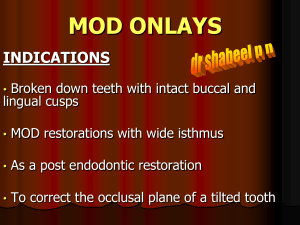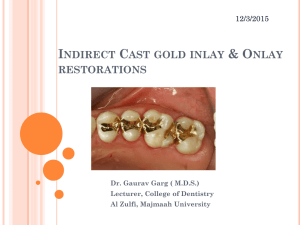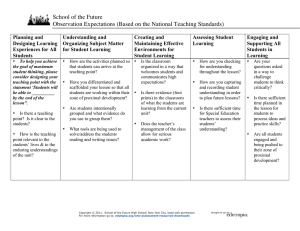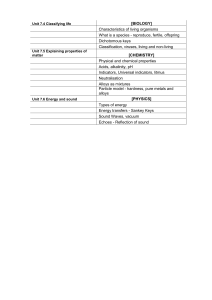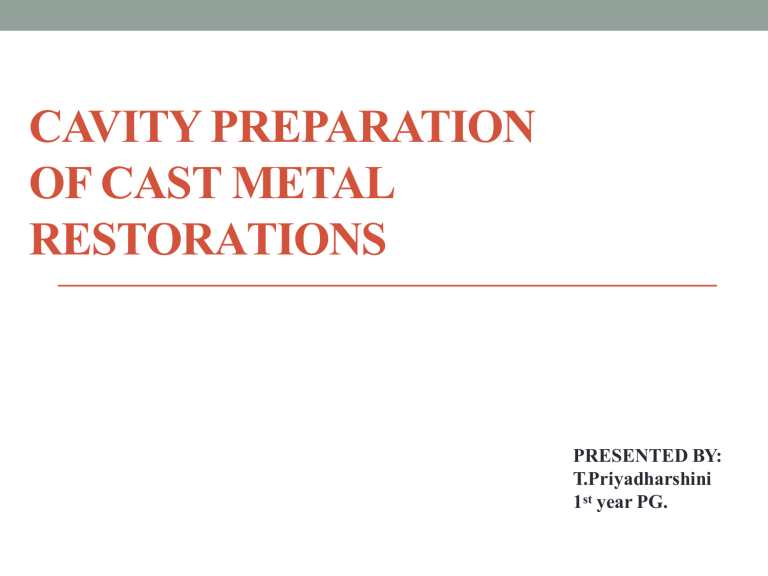
CAVITY PREPARATION OF CAST METAL RESTORATIONS PRESENTED BY: T.Priyadharshini 1st year PG. Introduction • The cast metal restorations are versatile and procedure requires meticulous care in preparation and laboratory procedures. • Dr. Phil Brook in 1897, was the first to introduce Inlay in dentistry who gave the concept of forming an investment around a wax pattern, eliminating the wax and filling the created mold with a gold alloy. • In 1907 Taggart changed the practice of restorative dentistry by introducing his technique of cast gold dental restorations. • It was most certainly Taggart who recognised the significance of cast gold restorations. Definitions Inlay - It is primarily intracoronal cast restoration that is fabricated outside the oral cavity and placed in prepared cavity. Onlay - An onlay is combination of intracoronal and extracoronal restoration when one or more cusps are covered. Materials For Cast Restoration • Until recently gold based alloys were the only choice for cast dental restorations. The ADA specification #25 still requires 75% of gold – plus – platinum group metals to be present in the alloys for cast restoration. • According to sturdevant, Traditional high gold alloys Low gold alloys Platinum-silver alloys Base metal alloys According to Marzouk, • Class 1 – gold and platinum based alloys • Class 2 – low gold alloys. Gold < 50% • Class 3 – non – gold platinum based alloys • Class 4 – nickel – chromium based alloys • Class 5 – castable , moldable ceramics Requirements of dental casting alloy • Biocompatability • Coefficient of thermal expansion • Melting range • Tarnish and corrosion resistance • Modulus of elasticity • Castability • Finishing and polishing • Esthetics and cost factor Gold alloys – class 1 • According to ADA #25, • - type 1 (83% Au, 10% Ag, 6% Cu) – soft gold alloys – for restorations subjecting to slight stress like inlay • - type 2 (77% Au, 14% Ag, 7% Cu) – medium hard alloys – for restorations with moderate stress like onlay. • - type 3 (75% Au, 11% Ag, 9% Cu) – hard alloys – high stress situations like onlay, short span FPD, veneer crowns. • - type 4 (69% Au, 25% Ag, 10% Cu) – extra hard alloys – high stress situations like long span FPD, crowns, endodontic post and core. Low gold alloys – class 2 • Economy gold alloys • Gold content lower than class 1 alloys • Palladium replaces gold. • Palladium is responsible for imparting the desirable physical properties, strength, hardness ant the plasticity of the mass. Non – gold platinum based alloys – class 3 • Composed mainly of palladium and silver. • They are either palladium – silver alloys or silver – palladium alloys. • Palladium is most influential in dictating the properties. • Also has indium, copper, tin, zinc constituting not more than 10%. • Indium acts as a scavenger while melting, and increases resistance to tarnish and corrosion. Nickel – chromium based alloys – class 4 • These metals are referred to as non-noble or non-precious alloys • • • • • because of their low cost. The chromium content in these alloys should not exceed 30%. The chromium imparts the passivating effect on base metals making them corrosion resistant. Beryllium and molybdenum have been added to improve upon properties of the base metals. Beryllium – control castability and oxidation Molybdenum – decreases co-efficient of thermal expansion. Castable moldable ceramics – class 5 • Composed of aluminium tri oxide( at least 50%) and magnesium oxide ( at least 15%) • Ratio of Al2O3 : MgO is 7:1 • To this 0.5% of stearate or wax is added to improve the moldability. • When heated above the glass transition temperature ( 30-150°) the mass becomes moldable and deformable. Physical and mechanical properties Type of cast metal Density gm/cm² Melting Tensile range °F strength PSI Yield strength 0.2% PSI Elongati M.E. on PSI Hardnes Tarnish s VHN and corrosio n rate Class 1 15 – 16 18002000 80,000 40,000 20-25% 10-12 million 150-170 Almost 0% Class 2 11 – 12 2200 100,000 47,000 20% 12 million 200 2-3% Class 3 10-11 2250 140,000 65,000 15 – 18% 15 million 250 5 – 10% Class 4 8 3500 160,000 80,000 3-11 % 30 million 315 0% Class 5 2.7 3300 19,000 - 0% 60 million 350 0% Indications • Large restorations • Endodontically treated teeth • Teeth at risk of fracture • Dental rehabilitation with cast metal alloy • Diastema closure and occlusal plane correction. • Prosthodontic abutment. • Correction of occlusion. • Wide open contacts. • Sub – gingival lesion. Contraindications • Physiologically young dentition with large pulp chamber. • Developing and deciduous tooth. • High plaque / caries index • Dissimilar metals. • Esthetics. • Small restoration. Advantage • Strength • Biocompatability • Low wear • Control of contour and contacts. Dis-advantage • Extensive tooth preparation • Cemented restoration, discrepancy and microleakage • Abarassive and splitting force on natural tooth • Galvanic currents. • Number of appointments and chair side time. • Cost and temporary restoration requirement. • Technique sensitive. Factors affecting the design of the cavity • Length of clinical crown. • Anatomic contours of the occlusal, proximal, buccal and lingual • • • • • surface. The position of tooth in arch. The occlusal and proximal relations. Unusual esthetic conditions, if any. The condition of soft tissues around the tooth. The extend and location of carious lesion. Mouth preparation prior to cast restoration For a single tooth cast restoration, every precaution should be taken to ensure that the longevity of the restoration. • Control of plaque. • Control of caries. • Control of periodontal problems. • Proper foundation. • Control of pulpal condition of tooth. • Occlusal equilibrium. • Diagnostic wax-ups and temporary restoration. • marzouk Burs used in cavity preparation • Bur no:271 – tungsten carbide tapering fissure bur with 0.8mm width. • Bur no:169L – tapering fissure with 0.5mm width. • Bur no:8862 – flame shaped diamond instrument. Principles of cavity preparation for cast restorations • Cast alloys can be used to restore intra-coronal or extra-coronal restorations. • Most single tooth restorations are a combination of these intra and extra coronal restorations. • Intracoronal restorations are mortise shaped, having definite walls and floors joined by line angles and point angles. • General principles of tooth preparation can be applied to intracoronal preparation with slight modifications for the effectiveness of the preparation. Outline form External outline form • External outline form should consist of straight lines and smooth following curves, avoiding any short angles. • Cavosurface margin placed is placed on sound, unbroken tooth tissue to obtain a well fitting casting. • Placement of bevels make the outline form slightly wider. Internal outline form: • The pulpal floor and the axial wall of the inlay preparation should be placed in the dentin and care should be taken to protect the pulp. • Line angles in both occlusal and proximal portions of the preparations should be well defined and the axio-pulpal line angle slightly rounded. • It is sometimes desirable to incline the cutting instrument so that it forms either an exaggerated taper from the cavosurface to pulpal floor or a long bevel on that area. Outline form • Depth of the cavity is 1.75 to 2 mm from the central groove. • Long axis of 271 bur is held parallel to long axis of tooth crown at all times. • For mandibular molars and premolars the bur is tilted 5-10° lingually to conserve the strength of lingual cusp. • After occlusal outline preparation, the cavity is extended proximally as in Black’s class 2 preparation. Outline form • Proximal ditch cut is made. • 0.3 mm of enamel and 0.5 mm of dentin is cut since the width of the bur is 0.8 mm. • Gingival seat is kept just below the contact area. • In ideal box , the buccal and lingual walls should be perpendicular to proximal surface clearing adjacent tooth by 0.5mm. • Depth is 0.2 – 0.5 mm in the dentin. Outline form • Ragged enamel edges at the gingival and proximal areas may be removed using hand instrument such as chisel or flame shame shaped diamond point. • However it is better to postpone the finishing till the remaining caries and/or old restorative material is completely removed and the base is applied. • Width of the cavity – 1/3rd of the cuspal inclines is included on both sides of the central groove. • In madibular premolar, 2/3rd of occlusal width is placed on the buccal inclined plane and 1/3rd from lingual incline plane. Mandibular premolar preparation Preparation path • Single insertion path • Opposite to occlusal loading force. • Parallel to long axis of the tooth. • Helps in retention and decrease its micromovements during function. • The occlusal force should seat the restoration rather than displace it. Resistance And Retention Form • Parallel opposing walls aids in retention. • Flat pulpal and cervical floors – resistance form. • Well defined angles help in maintaining precise relationship between restoration and tooth tissue improving retention and resistance. • Divergent walls – 2-6° taper increased in case of deeper cavity but not exceeding 10°. Factors affecting proximal margins • The extend of tooth tissue loss • The location of that loss. • Configuration of tooth i.e curvatures and embarasures. • The relationship with adjacent teeth. • The need for extra retentive devices. Pulpal floor • The pulpal floor should be flat. • It should be 1 – 1.5 mm from DEJ. • The pulpal floor should meet all the surrounding walls at definite line angles except for the axiopulpal line angle where it should be rounded. Features for resistance and retention • Axiopulpal line angle rounded to dissipate stress equally. • Occlusal dovetail or interlock prevents proximal displacement of restoration. • If no proper parallelism or no proper depth of cavity is there then secondary retentive devices like slots and pinholes can be given. • Shallow retentive grooves , 0.3mm deep, maybe given on buccoaxial and linguoaxial line angles. – indicated when preparation is shallow. Preparation Of Retentive Groove Bevelling Axio-pulpal Line Angle And Mesial Marginal Ridge Preparation Features For Circumferential Tie • The weakest link in any cast restoration is the teeth/cement/cast • • • • • • • joint. The peripheral marginal anatomy is called circumferential tie. Bevel – plane of the cavity wall or floor directed away from the cavity preparation. Bevel helps in - lap sliding fit at the gingival margin - results in 30° metal that is burnishable. - Weak enamel is removed. Bevels should include surface defects and supplementary grooves. Types of Bevels 1. 2. 3. 4. 5. 6. Partial bevel – not more than 2/3rd of enamel. Enameloplasty. Short bevel – entire enamel without dentin. For gold alloys. Long bevel – entire enamel and one half of dentinal wall. Intracoronal cast restorations. Full bevel – whole of enamel and dentin. Not used due to lack of retention. Reverse bevel – for cusp capping. Usually on facial and lingual surface of cusp. Hollow ground bevel – in the form of concavity. For materials with low castability. Not used. Preparation of bevels and flares • The slender flame shaped fine-grit diamond is used to bevel the occlusal and gingival margins and to apply the secondary flare on the facial and lingual walls. • This result in 30-40° marginal metal and 140-150° cavosurface margin. Types And Features Of Facial And Lingual Flares • Flares are present on the proximal box of intra-coronal cast preparations. Two types of flares: 1. Primary flare – similar to long bevel formed on the facial and lingual wall of proximal box. It has angulation of 45° to the inner dentinal wall proper. Funtions : makes the proximal portion of the restoration self cleansable. 1. Secondary flare – it is a flat plane superimposed peripherally to a primary flare. Indicated in lesions with wide contact areas and wide bucco-lingual extensions. Primary And Secondary Flare Difference between Amalgam and Cast restoration Modifications of proximal box preparation • Box preparation • Slice preparation • Auxiliary slice preparation • Modified flare Box preparation Introduced by Dr.G.V.Black Proximal cavities are box shaped. Advantages are • Resistence and retention form • The outline form can be made on all types of teeth. • Minimum display of metal. Disadvantages are • Involves removal of lot of tooth structure. • Time consuming clinically. • Narrow bevels leave a sharp edge and an undercut gingivally, which cannot be reproduced satisfactorily. • While taking impressions, distortions and breaking of wax pattern occurs Box preparation Slice preparations • This form of cavity is modified so that the proximal surface is flat without definite side walls. • Retention mainly depends upon occlusal key, locks cut in the axial wall. Indications • As abutment in bridge work. • Teeth with proximal undercuts can be eliminated which facilitates taking impression. • For indirect wax pattern technique. Slice preparations Advantages : • Less tooth structure is sacrificed. • Quicker and easier. • Well protected enamel margins. • Increase resistence and retention by exposing larger amount of tooth structure. Disadvantages : • It displays more amount of gold. (Thoma 1951) • Direct wax pattern cannot be made as distinguishing between margins become difficult. • Metal margins are likely to distort due to less thickness. Slice preparations It involves conservative disking of proximal surface to establish buccal and lingual extend of finish lines and provide a lap joint. Auxiliary slice preparations • Wraps partially around the proximal line angles, thus providing additional support. • Resistance form is enhanced • Provide external retention form. Modified flare preparation • Modified flare is a combination of box preparation and slice preparation. • Minimum disking of proximal walls is done for better finishing and polishing. Secondary modes of retention Luting cement • Fills gaps between the inlay and the tooth giving a physio chemical bonding. • Physical – zinc phosphate • Chemical – glass ionomer cement • The exposed cement dissolves in oral cavity . So it should not be considered as a retentive factor grooves • The grooves are placed in the bucco-axial and linguo-axial line angles with 169L bur. • It is placed at the expense of buccal and lingual walls and never at the expense of axial wall. • Its depth is 0.3mm. Reverse bevel • It is given on the gingival seat. This bevel has three planes. • First – reverse bevel plane where the inclination is on the gingivoaxial plane which prevents proximal displacement of the restoration. • Second – flat plane made of dentin. • Third – plane that is sloping away from the axial wall made up of enamel and dentin. This helps in preventing proximal displacement Internal box • It is made on the pulpal floor, which improves retention by 4-5 times. • It should have sharp line and point angles and definite walls. • This prevents micro movements of the inlay. • Internal box should always be reciprocated with reverse bevel or groove . Roughening of the pulpal floor • Pulpal floor is made more retentive by irregularities and lateral locking. • The irregularities should not have undermined enamel. Precementation grooves. • After casting, making grooves on the walls of inlay and/or on the cavity wall exactly opposite . • This will house a solid mass of the cement and help in good retention. Electrolytic etching of inlay. • This gives hinge like projections • Procedure – the proximal and occlusal surface is protected with wax and kept in electrolyte solution of 0.5 normal nitric acid. • Inlay is kept in anode and metal with greater EMF in cathode • Current causes microporosities in inlay surface that enables the luting cement to flow into it for better retention • This takes 10-15 min Tooth preparations for onlay cast restorations It is partly intracoronal restoration and partly extracoronal restoration, which has cuspal protection as main feature. Indications • Cuspal protection is considered when the lesion width is 1/3rd to ½ the • • • • intercuspal width. Cuspal protection is mandated when the length:width ratio is more than 2:1 . When there is a need to change the dimention, shape and inter relationship of the occluding surfaces, onlay cavity is considered as it is more conservative. Ideal for abutment teeth for RPD or FPD. When inclusion of wear facets that exceed the cusp tips and triangular ridges are necessary, onlay is considered. General shape • Onalys are dovetailed internally and follow the cuspal anatomy externally. • Proximal box are cone shaped. • The main feature of the design is capping of functional cusp and shoeing of non functional cusps. Tooth preparation for onlay Occlusal preparation • The initial entry is made in the central fossa to a depth of 1mm into dentin( 2.5mm in total depth). • The occlusal outline form must be as conservative as possible. • The bur is kept in long axis of the tooth so that a taper of 3-5 deg divergence is provided to the internal walls. Proximal preparation • The boxes are created on the proximal surface. • The facial and lingual walls should exhibit a combined divergence of 6 to 10 deg from each other as was provided in the occlussal area of the preparation • The facio-lingual dimension is likely to be determined by the presence of restoration, caries lesion. • The bevels will extend the preparation slightly beyond the proximal contact area so that the margins of the restoration will be accesible for finishing with a disk. Cuspal reduction • A carbide bur or a diamond bur is used to reduce the cusps. • Depth cuts of 1.5-2mm are made for the centric cusps and 1mm for non centric cusps. • After depth cuts are made, a uniform reduction of cusp that parallels the anatomic contours of the occlusal surface is made. Shoulder preparation • A shoulder is prepared on the external surface of the centric • • • • cusp to provide a band of metal to protect the tooth. The bur is held parallel to the external surface of the tooth and a shoulder about 1mm in height and 1mm axial depth is cut. The finish line should extend at least 1mm beyond occlusal contact. The occluso-axial line angles are rounded. Adequate clearance of 1-1.5mm in all eccentric mandibular positions. Non – centric cusp • A chamfer or long bevel is given on non-centric cusp. • A barrel shaped bur can be used to create chamfer. • The bur is positioned at 45 deg to the axial surface. • This provides additional cusp protection. Gingival bevel • A smooth distinct bevel on the gingival margin is established with no:7901 bur or GMT. • The bevel should be 0.5mm width and at 45 deg to the external root surface. Shoulder bevel: • A 1mm bevel is placed on the shoulder with no:7901 bur. • This bevel is blend with the proximal bevels. • Any sharp angles at the junction of various bevels and across the occluso-axial line angles are eliminated. Proximal bevels: • The proximal bevel or flare is established with a fine tapered diamond. • Divergence established from gingival floor occlusally. • The proximal bevel should blend smoothly with the gingival beval, lingual and buccal bevels. Retention grooves • Retention grooves are placed in the proximal boxes. • The grooves should be present bisecting the facio-axial line angle and the linguo-axial line angle. • The grooves should diverge occlusally.
